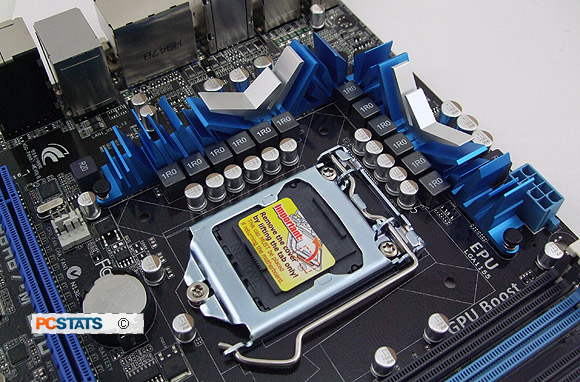
|
The ASUS P8H67-M Evo is a decent Intel H67 based microATX motherboard for mainstream computer builders focused on the popular socket LGA1155 Intel 2nd
Generation Core i3/i5/i7 2xxx-series 32nm Sandy Bridge processor family.
78% Rating: 
|
|
|
|
Home >
Reviews >
Motherboards >
ASUS P8H67-M Evo |
|
|
360-Degree Motherboard Gallery: Continued
The mATX ASUS P8H67-M Evo motherboard has four dual channel memory DIMMs which can
accommodate up to 4GB of DDR3-1066/1333 RAM in 32-bit Operating Systems, 32GB in
64-bit Windows 7.
Passive aluminum heatsinks cool the motherboards' 8+2 phase VRM
and MOSFETs.
|

Socket LGA1155 for Intel
2nd-Generation Core i3/i5/i7 2xxx-series
processors.
|
Like all Intel H67 platforms, the ASUS P8H67-M Evo
motherboard supports Intel socket LGA1155 2nd Generation 'Sandy Bridge' Core
i3/i5/i7 2xxx-series processors which contain an on-die
Intel HD 2000/3000 integrated graphics core.
The CPU
socket is not backwards compatible with socket LGA1156 CPUs, however
heatsinks are inter-compatible between socket LGA1155 and
socket LGA1156 motherboards. Frostytech.com has an excellent inventory of heatsink reviews,
check 'em out why don't you!
ASUS MemOK is a feature that lights up
when a memory module is not properly installed. Pressing the button will command
the system to run through several failsafe memory settings at boot if
you suspect a memory stick is bad. The red light is part of the
Q-Led system... basically a red light indicating a device isn't correctly installed, or
that item is preventing the PC from booting.
Asus' Energy Processing Unit
(EPU) is built into the motherboard with a physical IC. What
the EPU does is dynamically alter the amount of power phases
the motherboard uses depending on usage and system load. ASUS EPU is enabled with this
switch here, allowing it to dynamical adjust power draw and monitor usage.
GPU Boost can increase the speed of the IGP a little,
without needing to make adjustments in the BIOS. IGP overclocking is
a mixed bag... buy a videocard instead. :)
On this motherboard two USB 3.0 ports are provided by an
ASMedia controller. While USB 2.0's 480Mb/s maximum bandwidth was fine for small
flash-drives of the past, USB 3.0 expands that bandwidth to a massive 4.8Gb/s.
With the ASUS P8H67-M Evo
motherboard you get HDMI, Display Port, DVI
and Analog VGA video outputs to choose from. Any two of the four video outputs can be used
at the same time to take advantage of the Intel HD 3000 integrated
graphic core made available by the Sandy Bridge + Intel H67 chipset combo. The
HDMI and DVI ports support resolutions of 1920x1200. The Display Port goes to
2560x1600 while Analog VGA supports 2048x1536
ASUS has put some effort into improving the
build quality of its boards, the ASUS P8H67-M Evo only uses solid-state
capacitors for example.
Next up, BIOS and Benchmarking!
|
